Insect Feed Market Size
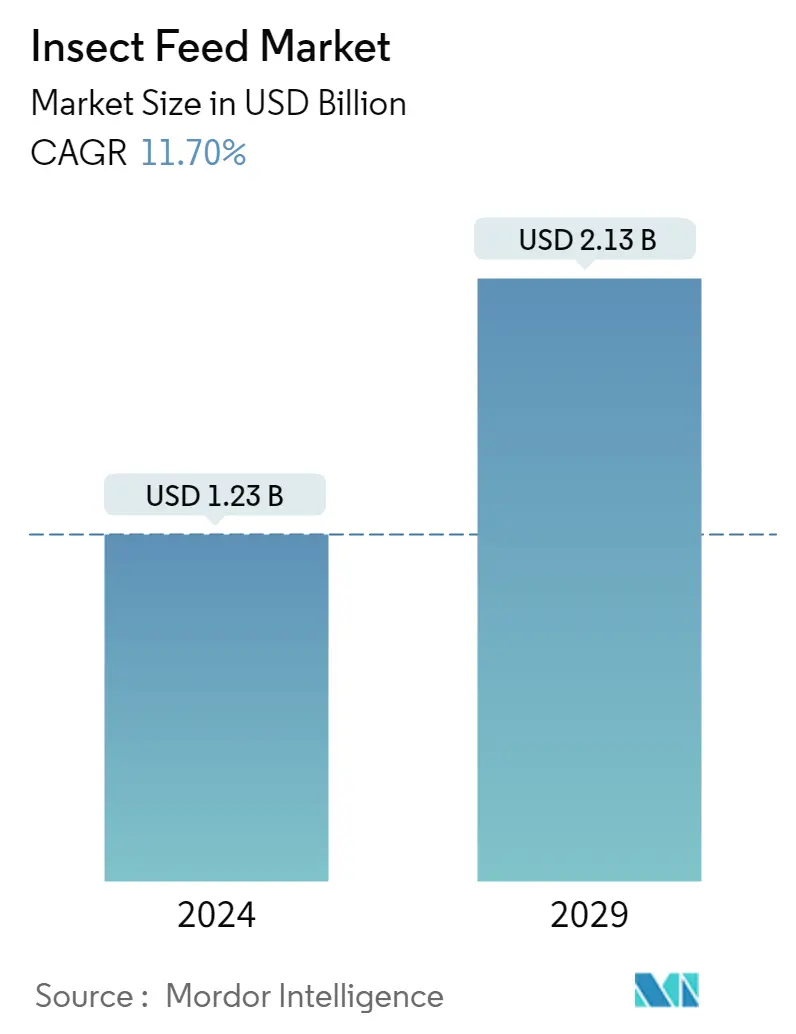
| Study Period | 2019 - 2029 |
| Market Size (2024) | USD 1.23 Billion |
| Market Size (2029) | USD 2.13 Billion |
| CAGR (2024 - 2029) | 11.70 % |
| Fastest Growing Market | Europe |
| Largest Market | Asia-Pacific |
Major Players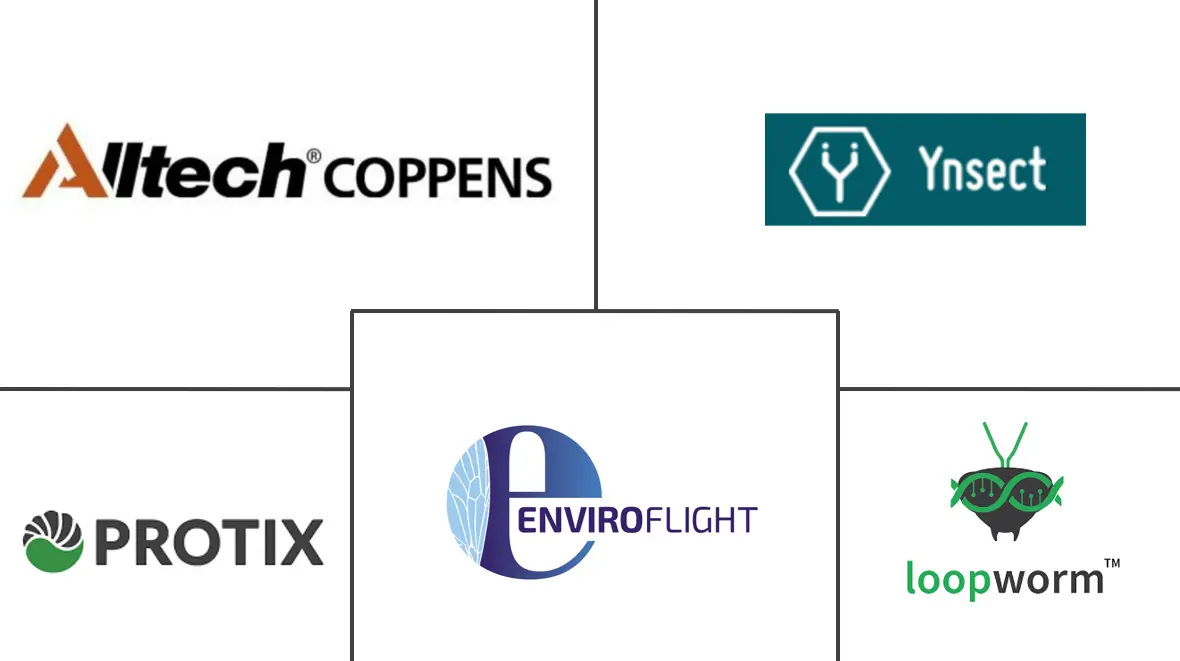
*Disclaimer: Major Players sorted in no particular order |
Insect Feed Market Analysis
The Insect Feed Market size is estimated at USD 1.23 billion in 2024, and is expected to reach USD 2.13 billion by 2029, growing at a CAGR of 11.70% during the forecast period (2024-2029).
- The insect feed sector, at present, has challenges, such as commercial-scale production, when compared to conventional animal feed products. However, major factors, including new investments by private venture capital (VC) firms in the insect feed market, were noted over the study period due to the market's rising demand on a global scale. For instance, in June 2021, KeyyakVenture, a Chilean venture capital firm, invested USD 4.5 million in Food for the Future (F4F), a start-up that manufactures insect feed that is situated in Chile. As a result, these VC companies' growing investments demonstrate their belief in expanding this market. Along with this, insects' high feed conversion ratio, low space requirements, supportive regulatory regulations, etc., are driving the insect feed market.
- Additionally, the increasing demand for farmed fish across the world led to a rise in the prices of fishmeal and fish oil. The insect feed serves as a viable protein-rich option for aquafeed. For the past 20 years, investigations have been carried out on insect meals as alternative sources for fishmeal. Thus far, the result of replacing fishmeal in feeding aquaculture species has been promising. Furthermore, as viable animal feed, insects have been receiving increasing recognition due to their high energy and protein content. The advantage of insect feed compared to fresh or unprocessed dried insects is that it can easily be mixed with other feed components, such as ground grains and soy, to form a mixture of the desired composition that is then pressed into pellets for better and more convenient feeding to animals.
- Also, insect feed enhances the immune system and reduces antibiotic use. Thus, it promotes animal health. Moreover, the poultry industry's usage of insects as feed is increasing. Feeding grasshoppers to chickens improves the shelf life of the meat. Using insect feed in the diet reduces feed costs and enhances the performance and health of broiler chickens. Thus, insect meal is an acceptable, inexpensive, and preferable source of protein for poultry. Thus, the maintenance of vast poultry by the farmers, along with other market drivers, is projected to boost the market during the forecast period.
Insect Feed Market Trends
This section covers the major market trends shaping the Insect Feed Market according to our research experts:
High Feed Conversion Ratio of Insects
The population on the earth is expected to increase to 9 billion by 2050. With a growing world population and increasingly demanding consumers, producing sufficient protein from livestock, poultry, and fish represents a severe challenge for the future. Approximately 1,900 insect species are eaten worldwide, mainly in developing countries. They constitute quality food and feed, have high feed conversion ratios, and emit low levels of greenhouse gases. Hence, the demand for the production and consumption of edible insects is increasing because of their high nutritional value and low risk of transmitting zoonotic diseases.
Insects contain more protein and low fat than traditional meats, such as poultry and livestock. They also emit fewer greenhouse gases and ammonia than conventional livestock and can be grown on organic waste. This is driving the market growth. Insects are efficient in converting feed into protein. For instance, crickets need 12 times less feed than cattle, four times less feed than sheep, and half as much feed as pigs and broiler chickens to produce the same amount of protein. Additionally, Estimates show that up to 80% of a cricket is edible and digestible, compared with 55% for chicken and pigs and 40% for cattle. Insects, being cold-blooded animals, do not require energy to maintain their body temperature and hence, require less feed. Thus, rearing these insects and their usage as feed for animals has become prominent in developed and developing countries.
The need for grain and protein feeds is likely to increase as the demand for meat rises. For instance, livestock requires about 6 kg of plant protein to get 1 kg of animal protein. Feed-to-meat conversion rates (amount of feed needed to produce a 1 kg increase in weight) vary widely depending on the animal types and the production practices used. Typically, 1 kg of live animal weight in the US production system requires the respective amount of feed, i.e., 2.5 kg of chicken, 5 kg of pork, and 10 kg of beef, whereas insects require much less feed. Thus, the high feed conversion ratio and high nutritional value of insects compared to livestock and poultry may drive the growth of the insect market during the forecast period.
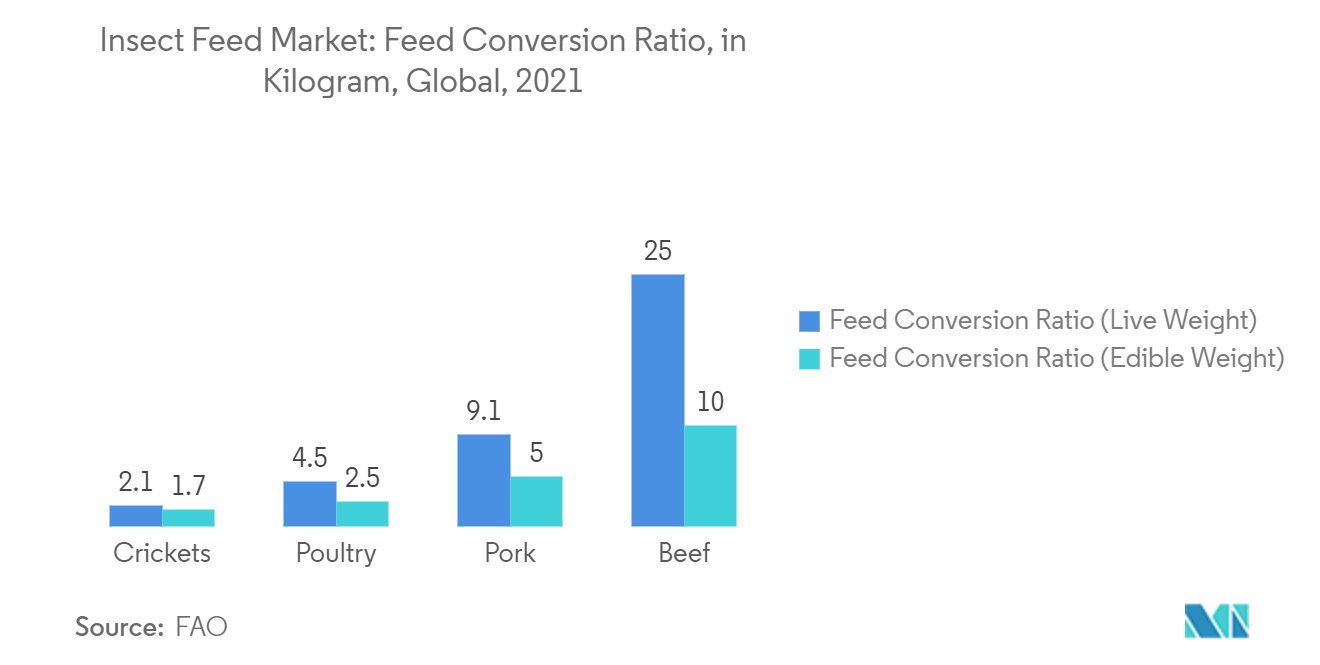
Asia-Pacific Dominates the Market
In Asia-Pacific, the growing meat consumption compelled the demand for nutritious insect feed in recent years. China is the largest market for insect feed in the Asia Pacific region. The consumption of meat is high and has been increasing from the past few years. According to the Organization for Economic Co-operation and Development (OECD), the per capita consumption of meat in China is expected to increase from 44.4 kg in 2020 to 52.84 kg in 2029. To meet the growing demand for nutritious meat in the country, livestock is being fed with protein-rich insects. This, in turn, has led to the development of the insect feed industry for livestock, such as poultry and swine, in China, driving the overall insect feed market in the country.
Along with this, insect farming is a unique breeding industry in rural China, and it is a source of income for local people. Insects are reared and bred for animal feed using two approaches in China. The insects are either fully domesticated and reared completely in captivity or are partially raised in captivity, and the insect habitat is manipulated to increase production. Furthermore, local Chinese companies, like Haocheng Mealworms Inc. and Guangzhou Wuliang Biotechnology Co. Ltd, have been producing insect feed rather than relying on soybean imports from the United States for animal feed, which drives to attain self-sustainability. Such developments in the country fuel the insect feed market's revenue in China. Hence, the region is anticipated to witness robust growth, owing to the increasing demand for insect feed across various countries, such as China, South Korea, and Japan, coupled with increased animal protein demand.
Furthermore, India is the second largest market for insect feed next to China. According to the FAO, in India, conventional feeds, such as soybean and maize account for 60% of the total cost of raising farm animals. Therefore, the focus is being shifted toward developing grasshopper feeds for farm animals in the country to save production costs and bridge the demand-supply gap of feedstuffs, such as maize and soybean, as a result of competition between humans and livestock for these resources. The gradual surge in demand for meat and meat-based products raised concerns over malnutrition since large swathes of farmland are diverted to grow resource-intensive poultry products. In July 2021, the Bangalore-based company, Nandus Foods, successfully experimented by replacing soy with insect protein and converting food waste into high-grade protein for poultry using the black soldier fly (BSF). These factors are driving the insect feed market in the country.
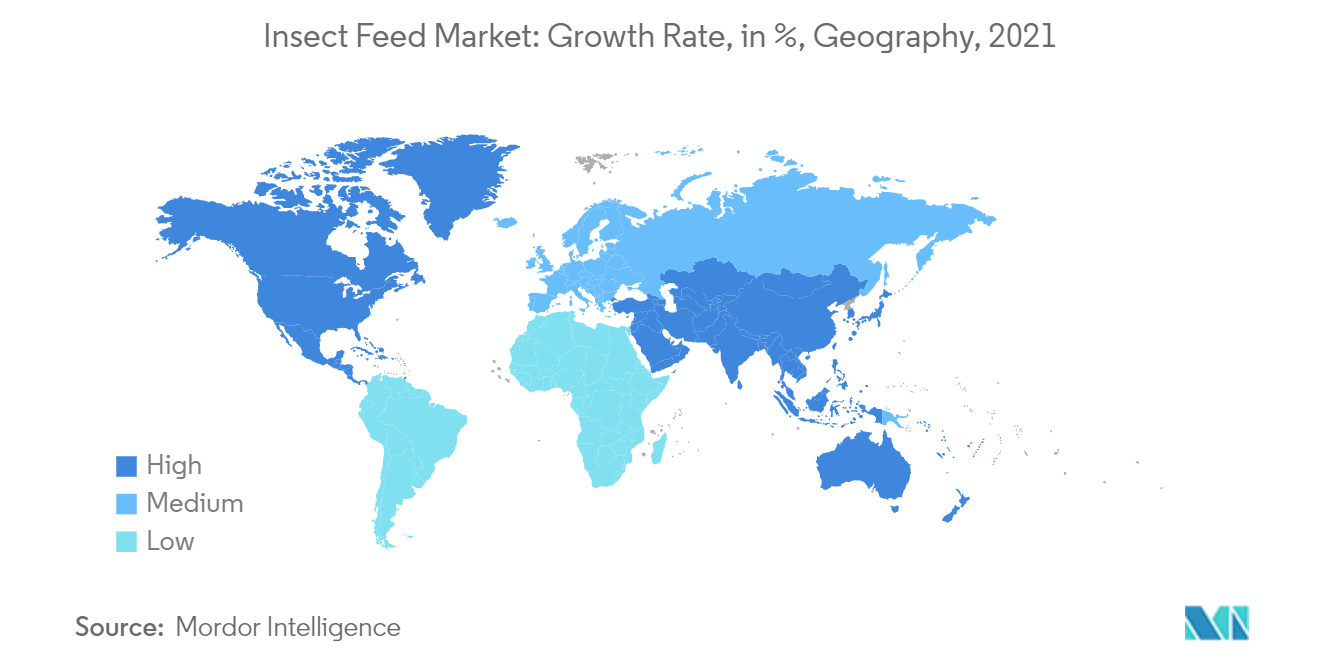
Insect Feed Industry Overview
The global insect feed market was observed to be highly fragmented in 2021, as most companies are new in the market studied and hold only a small fraction of the market share. As per the companies profiled in the study, Europe has most of the major players, followed by Asia-Pacific. Alltech Coppens, Protix, Loopworm, Ynsect, and Enviroflight were some prominent companies that accounted for the majority share in the global insect feed market in 2021. Acquisitions, partnerships, and expansions are some important strategies adopted by insect feed-producing companies for their research support and marketing purposes. For instance, Enviroflight, Alltech Coppens, and Protix are the three companies that successfully adopted these strategies.
Insect Feed Market Leaders
-
Alltech Coppens
-
Protix
-
Ynsect
-
Enviroflight
-
Loopworm
*Disclaimer: Major Players sorted in no particular order
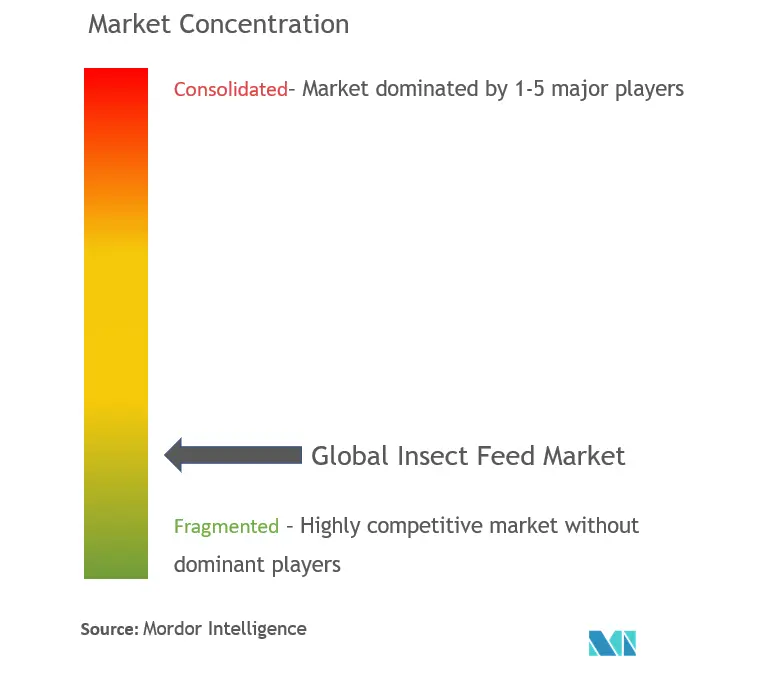
Insect Feed Market News
May 2022: Hipromine announced a partnership with WEDA Dammann & Westerkamp GmbH, a supplier of feeding technology solutions. As part of this venture, Weda supplies HiProMine with insects, including Black Soldier Fly (BSFL), aiding the company's development of its pet and animal nutrition products.
Feb 2022: Insect farmer Protix, which produces proteins for the feed for fish, farm animals, and pets, raised EUR 50 million (USD 51.4 million) for further international expansion and ground-breaking research and development.
February 2021: Innovafeed, along with Auchan, launched their third insect-fed animal feed line by introducing insect-fed pork, which has been fed with a diet incorporating insect oil for a reduced carbon footprint, focusing on sustainability.
Insect Feed Market Report - Table of Contents
1. INTRODUCTION
- 1.1 Study Assumptions and Market Definition
- 1.2 Scope of the Study
2. RESEARCH METHODOLOGY
3. EXECUTIVE SUMMARY
4. MARKET DYNAMICS
- 4.1 Market Overview
- 4.2 Market Drivers
- 4.3 Market Restraints
-
4.4 Porter's Five Forces Analysis
- 4.4.1 Bargaining Power of Suppliers
- 4.4.2 Bargaining Power of Buyers
- 4.4.3 Threat of New Entrants
- 4.4.4 Threat of Substitute Products
- 4.4.5 Intensity of Competitive Rivalry
5. MARKET SEGMENTATION
-
5.1 Animal Type
- 5.1.1 Aquaculture
- 5.1.2 Poultry
- 5.1.3 Swine
- 5.1.4 Other Animal Types
-
5.2 Geography
- 5.2.1 North America
- 5.2.1.1 United States
- 5.2.1.2 Canada
- 5.2.1.3 Mexico
- 5.2.1.4 Rest of North America
- 5.2.2 Europe
- 5.2.2.1 Germany
- 5.2.2.2 United Kingdom
- 5.2.2.3 France
- 5.2.2.4 Russia
- 5.2.2.5 Spain
- 5.2.2.6 Rest of Europe
- 5.2.3 Asia-Pacific
- 5.2.3.1 China
- 5.2.3.2 Japan
- 5.2.3.3 India
- 5.2.3.4 Rest of Asia-Pacific
- 5.2.4 South America
- 5.2.4.1 Brazil
- 5.2.4.2 Argentina
- 5.2.4.3 Rest of South America
- 5.2.5 Middle East and Africa
- 5.2.5.1 United Arab Emirates
- 5.2.5.2 Egypt
- 5.2.5.3 Rest of Middle East and Africa
6. COMPETITIVE LANDSCAPE
- 6.1 Most Adopted Strategies
- 6.2 Market Share Analysis
-
6.3 Company Profiles
- 6.3.1 Alltech Coppens BV
- 6.3.2 Hipromine SA
- 6.3.3 nextProtein
- 6.3.4 EnviroFlight LLC
- 6.3.5 Protix BV
- 6.3.6 InnovaFeed SAS
- 6.3.7 Nasekomo AD
- 6.3.8 Ynsect
- 6.3.9 Beta Hatch Inc.
- 6.3.10 Enterra Feed Corporation
- 6.3.11 Hexafly Enterprises Limited
- 6.3.12 Loopworm Private Limited
- *List Not Exhaustive
7. MARKET OPPORTUNITIES AND FUTURE TRENDS
** Subject To AvailablityInsect Feed Industry Segmentation
Insect feeds are meals enriched with high proteins blended from various raw materials and additives. These blends are formulated according to the specific requirements of the target animal, especially to use as an aquafeed. They are manufactured by feed compounders, such as meal types, pellets, or crumbles. For this report, only insect feed has been considered. The report covers an extensive study of segments and factors driving the growth of the commercial insect feed market.
The insect feed market is segmented by Animal Type (Aquaculture, Poultry, Swine, and Other Animal Types) and Geography (North America, Europe, Asia-Pacific, South America, and the Middle East and Africa. The report offers market sizing and forecasts in values in USD million for all the above segments.
| Animal Type | Aquaculture | |
| Poultry | ||
| Swine | ||
| Other Animal Types | ||
| Geography | North America | United States |
| Canada | ||
| Mexico | ||
| Rest of North America | ||
| Geography | Europe | Germany |
| United Kingdom | ||
| France | ||
| Russia | ||
| Spain | ||
| Rest of Europe | ||
| Geography | Asia-Pacific | China |
| Japan | ||
| India | ||
| Rest of Asia-Pacific | ||
| Geography | South America | Brazil |
| Argentina | ||
| Rest of South America | ||
| Geography | Middle East and Africa | United Arab Emirates |
| Egypt | ||
| Rest of Middle East and Africa |
Insect Feed Market Research FAQs
How big is the Insect Feed Market?
The Insect Feed Market size is expected to reach USD 1.23 billion in 2024 and grow at a CAGR of 11.70% to reach USD 2.13 billion by 2029.
What is the current Insect Feed Market size?
In 2024, the Insect Feed Market size is expected to reach USD 1.23 billion.
Who are the key players in Insect Feed Market?
Alltech Coppens, Protix, Ynsect, Enviroflight and Loopworm are the major companies operating in the Insect Feed Market.
Which is the fastest growing region in Insect Feed Market?
Europe is estimated to grow at the highest CAGR over the forecast period (2024-2029).
Which region has the biggest share in Insect Feed Market?
In 2024, the Asia-Pacific accounts for the largest market share in Insect Feed Market.
What years does this Insect Feed Market cover, and what was the market size in 2023?
In 2023, the Insect Feed Market size was estimated at USD 1.10 billion. The report covers the Insect Feed Market historical market size for years: 2019, 2020, 2021, 2022 and 2023. The report also forecasts the Insect Feed Market size for years: 2024, 2025, 2026, 2027, 2028 and 2029.
Insect Feed Industry Report
The global market for insect feed is segmented by animal type, including aquaculture, poultry, swine, and other animal types, and by geography, covering North America, Europe, Asia-Pacific, South America, and the Middle East and Africa. The industry report offers a comprehensive market analysis and forecast, providing insights into market trends and market growth. This market report includes a detailed market segmentation and market overview, offering valuable market data and market value estimations.
Industry reports and market research highlight the market outlook and industry outlook, emphasizing the market size and market leaders. Industry analysis and industry information also provide a thorough industry overview and industry statistics. The market forecast and market predictions are essential for understanding the market dynamics and market review.
This report example includes a free report PDF download, making it accessible for further industry research and industry sales analysis. The industry trends and market growth rate are crucial for understanding the market's future potential. This market report is an essential resource for research companies looking to gain insights into the insect feed market.



